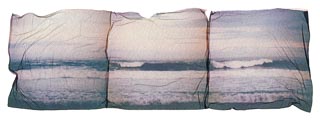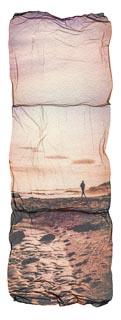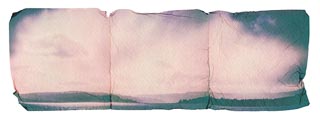Polaroid Waterscapes (FRPS)
I am very happy to say that in November 2020 I was awarded a Royal Photographic Society Fellowship distinction in the Fine Art category (now replaced by the Visual Art category). This involves writing a statement of intent (of up to 150 words in the Fine Art category) and creating a portfolio of 20 or 21 photographs that responds to it. My statement of intent and some background information is at the end of the page. I have also uploaded a Polaroid Waterscapes overflow gallery with prints which didn't make it into my final Fellowship submission, and a gallery with my RPS Associateship submission, called Secret Gardens of the Dead.
+ Statement of intent, hanging plan and background information
Statement of intent
The places where water meets and shapes the land produce an inspiring variety of mood, atmosphere and form. And Scotland, my adopted home for over 20 years, has countless examples.
I used Polaroid film and water to create a set of prints that I hope evokes the fragile and dynamic nature of the relationship between land and water. There is an exciting unpredictability about the way Polaroid film responds to the image and the way water shapes the Polaroid emulsion on the paper that reflects the unpredictable action of water on land.
The presence of occasional man-made elements serves as a reminder that although they have not been there long enough for water to have left the same marks it has on the land, these things are by no means immune. Eventually they too will succumb to one of nature's most powerful forces.
(143 words)
Hanging plan
 The hanging plan is an important part of an RPS distinction submission. Your prints will be hung according to your hanging plan before being assessed. It is essential that the prints together create a harmonious whole. If you are viewing this page on a large screen the images above will appear above according to my hanging plan (3 rows of 7 images), but if you are viewing this page on a device with a small screen you can see the correct hanging plan here.
The hanging plan is an important part of an RPS distinction submission. Your prints will be hung according to your hanging plan before being assessed. It is essential that the prints together create a harmonious whole. If you are viewing this page on a large screen the images above will appear above according to my hanging plan (3 rows of 7 images), but if you are viewing this page on a device with a small screen you can see the correct hanging plan here.
Background information
I produced these prints using a process called Polaroid Emulsion Lift. This process involves taking a normal Polaroid print, trimming off the white border, separating its two layers and putting the layer containing the layer of emulsion chemicals with the image in a tray of hot water. After a couple of minutes the emulsion layer will float freely in the water.
A piece of plain watercolour paper is then placed in the water under the emulsion layer and lifted out of the water so the emulsion layer sticks to it. While the paper is still wet the emulsion layer can be flattened out with a brush, but there will always be folds, tears and wrinkles produced by the action of the water. Getting 3 emulsion lifts to work together on a single sheet of paper takes some practice, but creating these prints was still a very relaxing and enjoyable process.
Water plays an elemental role in forming the prints and I felt this gave them a natural sympathy with the subject matter.
For more information on how I made these print see How to make Polaroid emulsion lift triptych prints




















